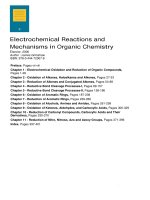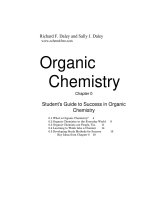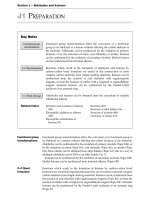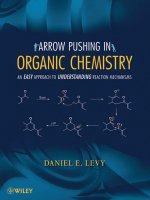1000 multiple choice questions in organic chemistry
Bạn đang xem bản rút gọn của tài liệu. Xem và tải ngay bản đầy đủ của tài liệu tại đây (1.38 MB, 185 trang )
www.pdfgrip.com
1000
Multiple-ChoiceQuestionsinOrganic
Chemistry
Multiplechoicequestionsusuallyincludeaphraseorstemfollowedbythreeto
fiveoptions/choices.
Teststrategies:
•Readthedirectionscarefully
•Knowifyouarepenalizedforguessing
•Answereasyquestionsfirst
Answeringoptions:
•Improveyourodds,thinkcritically
•Hidetheoptions,readthestem,andtrytoanswer
Selecttheoptionthatmostcloselymatchesyouranswer
•Readthestemwitheachoption
Treateachoptionasatrue-falsequestion,andchoosethe“mosttrue”
Strategiestoanswerdifficultquestions:
•Eliminateoptionsyouknowtobeincorrect
•Questionoptionsthataretotallyunfamiliartoyou
•Questionoptionsthatcontainnegativeorabsolutewords
•“Alloftheabove”
Ifyouknowtwoofthethreeoptionsseemcorrect,“alloftheabove”isastrong
possibility
•Numberanswers:
Tossoutthehighandlowandconsiderthemiddlerangenumbers
•“Lookalikeoptions”
Probably one is correct; choose the best but eliminate choices that mean
basicallythesamething,andthuscanceleachotherout
•Echooptions:
Iftwooptionsareoppositeeachother,chancesareoneofthemiscorrect
•Iftwoalternativesseemcorrect,
comparethemfordifferences,
thenrefertothestemtofindyourbestanswer
www.pdfgrip.com
Guessing:
•Alwaysguesswhenthereisnopenalty
forguessingoryoucaneliminateoptions
•Don’tguessifyouarepenalized
forguessingandifyouhavenobasisforyourchoice
•Don’tchangeyouranswer
unlessyouaresureofthecorrection
When taking a test you are demonstrating your ability to understand your course
material. Successful test taking avoids carelessness. Stay relaxed and confident.
Remind yourself that you are well-prepared and going to do well. If you find
yourself anxious, take several slow, deep breaths to relax. Don’t talk about the
teststootherstudentsjustbeforeit;anxietyiscontagious.
This unit includes 1000 multiple choice questions. The purpose is to assess the
breadthofstudent’sknowledgeandunderstandingofthebasicconceptsoforganic
chemistry.Rememberthatthemultiplechoicequestions:
1.arenotsimplydefinitions.
2.requireapplicationofrecalledinformation,notsimplerecall.
3.requirefinedistinctionsbetweencorrectandnearly-correctstatements.
4.emphasizeconceptualunderstanding
These questions have been especially designed to cover all the important
conceptsoforganicchemistry.Solvethemcarefully.Youwillbegladthatyou
did!
1.Whichofthefollowingisnotacharacteristicoforganiccompounds?
(a)Theyusuallyhavelowmeltingpoints.
(b)Theyusuallyareonlyslightlysolubleorinsolubleinwater.
(c)Ifwatersolubletheyseldomconductanelectriccurrent.
(d)Bondswhichbindtheatomstogetherarenearlyalwaysionic.
Answer.(d)
2.Theelementleastlikelytobefoundinanorganiccompoundis
(a)oxygen
(b)sulfur
(c)nitrogen
(d)silicon
Answer.(d)
3.Oneofthemajorsourcesoforganiccompoundsis
www.pdfgrip.com
(a)Naturalgas
(b)Fermentation
(c)Seawater
(d)Atmosphere
Answer.(a)
4.Catenationisapropertyofthecarbonatomwhichdescribesitsabilityto
(a)bondwithothercarbonatoms
(b)formdoubleandtriplebonds
(c)existinplantandanimalform
(d)formbondsinitsgroundstate
Answer.(a)
5.Instableorganiccompounds,carbonwillalwaysform
(a)2bonds
(b)4bonds
(c)3bonds
(d)5bonds
Answer.(b)
6.Carbon-carbondoublebondsconsistof:
(a)oneσbond,oneπbond
(b)twoσbonds,oneπbond
(c)oneσbond,twoπbonds
(d)twoσbonds,twoπbonds
Answer.(a)
7.Acetylenehasatotalof:
(a)oneσbond,twoπbonds
(b)twoσbonds,fourπbonds
(c)threeσbonds,twoπbonds
(d)oneσbond,fourπbonds
Answer.(c)
8.Inpropenethereare
(a)eightσbondsandoneπbond
(b)sevenσbondsandtwoπbonds
(c)sixσbondsandthreeπbonds
(d)nineσbonds
Answer.(a)
9.Inpropynethereare
(a)sixσbondsandtwoπbonds
www.pdfgrip.com
(b)sevenσbondsandoneπbond
(c)sixσbondsandoneπbond
(d)eightσbonds
Answer.(a)
10.1-Buten-3-ynehas
(a)sixσandfourπbonds
(b)sevenσandthreeπbonds
(c)eightσandtwoπbonds
(d)nineσandoneπbond
Answer.(b)
11.Compoundinwhichcarbonsuseonlysp3hybridorbitalsforbondformationis
(a)CH3CH2CH3
(b)CH3C≡CH
(c)CH3CH=CH2
(d)CH2=CH—CH=CH2
Answer.(a)
12.Compoundinwhichcarbonusessp3hybridorbitalsforbondformationis
(a)
(b)
(c)
(d)(CH3)3COH
Answer.(d)
13.Whenthecarbonatomissp2hybridizedinacompound,itisbondedto
(a)2otheratoms
(b)4otheratoms
(c)3otheratoms
(d)5otheratoms
Answer.(c)
14.Compoundinwhichcarbonsuseonlysp2hybridorbitalsforbondformationis
(a)
www.pdfgrip.com
(b)
(c)CH2=CH–CH=CH2
(d)CH3CH=C=CH2
Answer.(c)
15.Whichofthefollowingisaplanarmolecule?
(a)Formaldehyde
(b)Acetone
(c)Formicacid
(d)Aceticacid
Answer.(a)
16.Whatisbondanglebetweenthehybridorbitalsinmethane?
(a)180°
(b)120°
(c)109.5°
(d)115.5°
Answer.(c)
17.TheH–C–Cbondangleinethaneis
(a)60°
(b)109.5°
(c)120°
(d)118°28′
Answer.(b)
18.TheH–C–Hbondangleinethyleneis
(a)60°
(b)120°
(c)90°
(d)180°
Answer.(b)
19.Whatisthebondlengthofacarbon-carbondoublebond?
(a)1.20Å
(b)1.34Å
(c)1.54Å
(d)1.68Å
Answer.(b)
20.Thecarbon-carbonbondlengthsinrankofincreasingbondlengthis:
www.pdfgrip.com
(a)triple,double,single
(b)single,double,triple
(c)single,triple,double
(d)triple,single,double
Answer.(a)
21.Whichofthefollowingisthecorrectorderofbondlengths:
(a)C–C
(c)C≡C>C–C>C=C
(d)C≡C<C–C>C=C
Answer.(a)
22.WhichofthefollowinghydrocarbonshastheshortestC–Cbondlength?
(a)CH2=CH2
(b)CH3CH3
(c)HC≡CH
(d)
Answer.(c)
23.Thecarbon-carbonbondlengthismaximumin
(a)CH2=CH2
(b)CH3CH3
(c)HC≡CH
(d)
Answer.(b)
24.Whatisthehybridizationofthecarbonatomsnumbered1and2respectively
inthefollowingstructure?
(a)sp3,sp2
(b)sp2,sp2
(c)sp,sp
(d)sp2,sp
Answer.(d)
25.Howmanyatomsareattachedtoanatomhavingasphybridization?
(a)0
(b)1
www.pdfgrip.com
(c)2
(d)3
Answer.(c)
26.Whichstatementistrue?
(a)Resonancehybridsareinherentlyunstable.
(b)Resonancehybridsaremorestablethananyindividualresonanceform.
(c) Resonance hybrids are averages of all resonance forms resembling the less
stableforms.
(d)Resonancehybridsareaveragesofallresonanceformsresemblingthemore
stableforms.
Answer.(d)
27.Resonancestructuresofamoleculehave
(a)samearrangementofatoms
(b)differentarrangementofatoms
(c)samenumberofpairedelectrons
(d)differentnumberofpairedelectrons
Answer.(a)and(c)
28.Whichofthefollowingcompoundshaveplanarmolecules?
(a)ethylalcohol
(b)formaldehyde
(c)diethylether
(d)1,3-butadiene
Answer.(b)and(d)
29.Whichofthefollowingcompoundswillshowdipolemoment?
(a)cis-1,2-dichloroethylene
(b)o-dichlorobenzene
(c)trans-1,2-dichloroethylene
(d)p-dichlorobenzene
Answer.(a)and(b)
30.Whichmoleculehasanonzerodipolemoment?
(a)Cl2
(b)CO2
(c)CCl4
(d)CHCl3
Answer.(d)
31.Whichofthefollowingcompoundshavelowestdipolemoment?
(a)carbontetrachloride
www.pdfgrip.com
(b)chloromethane
(c)dichloromethane
(d)chloroform
Answer.(a)
32.Whichmoleculehasthegreatestdipolemoment
(a)CH3Cl
(b)CH3Br
(c)CH3F
(d)CH3I
Answer.(c)
33.Whichofthefollowingcompoundshavehighestdipolemoment?
(a)dichloromethane
(b)chloroform
(c)chloromethane
(d)carbontetrachloride
Answer.(a)
34.HomolyticfissionofC–Cbondleadstotheformationof:
(a)Freeradicals
(b)Carboniumions
(c)Carbanions
(d)Noneofthese
Answer.(a)
35.Homolyticfissionofcovalentbondbetweencarbonatomswillproduce:
(a)Twocarboniumions
(b)Twomolecules
(c)Freeradicals
(d)Carboniumionandcarbanion
Answer.(c)
36.Theorderofstabilityofcarboniumionsis
(a)tertiary>secondary>primary
(b)secondary>tertiary>primary
(c)primary>secondary>tertiary
(d)primary>tertiary>secondary
Answer.(a)
37.Theorderofstabilityofcarbanionsis
(a)primary>secondary>tertiary
(b)secondary>tertiary>primary
www.pdfgrip.com
(c)tertiary>secondary>primary
(d)tertiary>primary>secondary
Answer.(a)
38.Whichofthefollowingcarboniumionswillbemoststable?
(a)
(b)
(c)
(d)
Answer.(d)
39.Theleaststablecarbanionis:
(a)
(b)
(c)
(d)
Answer.(b)
40.Whichalkylfreeradicalisthemoststable?
(a)methyl
(b)primary
(c)secondary
(d)tertiary
Answer.(d)
41.Whichofthefollowingisanelectrophile?
(a)
(b)
(c)
(d)
Answer.(b)
42.Whichofthefollowingisnotanelectrophile?
(a)NH3
(b)Br+
(c)AlCl3
(d)NO2+
Answer.(a)
43.Whichofthefollowingstatementsiscorrectregardingnucleophiles?
(a)Theyhaveanoverallpositivecharge
www.pdfgrip.com
(b)Theyhavealone-pairofelectrons
(c)Theyhaveanunpairedelectron
(d)Theyhaveemptyorbitals
Answer.(b)
44.Whichofthefollowingisanucleophile?
(a)AlCl3
(b)H3O+
(c)BF3
(d)CN–
Answer.(d)
45.Whichofthefollowingisnotanucleophile?
(a)NH3
(b)HSO3–
(c)AlCl3
(d)HO–
Answer.(c)
46.Whichofthefollowingisnotanucleophile?
(a)
(b)BF3
(c)
(d)NH3
Answer.(b)
47.WhichofthefollowingisaLewisacid?
(a)AlCl3
(b)CH3OH
(c)NH3
(d)CH3OCH3
Answer.(a)
48.Whichofthefollowingrangesbestrepresentsthestrengthofahydrogenbond?
(a)5-10kcals
(b)60-80kcals
(c)80-100kcals
(d)100-120kcals
Answer.(a)
49.Whichdescribesthebondstrengthorbonddissociationenergy?
(a)energyrequiredtobreakabond
(b)energyreleasedwhenabondbreaks
www.pdfgrip.com
(c)energyreleasedwhenabondisformed
(d)(a)and(c)
Answer.(d)
50.Whichstatementiscorrect?
(a)Energyisreleasedwhenabondbreaks.
(b)Asigmabondresultsfromattractionofprotonsandelectrons.
(c)Energyisreleasedwhenabondforms.
(d)Acarbanionispositivelycharged.
Answer.(c)
51.Whichofthefollowingisincorrect?
(a)Resonance stabilization is the extra stability a compound gains from having
delocalizedelectrons.
(b)Delocalizedelectronsdestabilizeacompound.
(c)Thegreaterthenumberofrelativelystableresonancecontributors,thegreater
istheresonancestabilization.
(d)(a)and(c)
Answer.(b)
52.Whichofthefollowingiscorrect?
(a)Curvedarrowsarealwaysdrawnfromanelectronpoorcentertoanelectron
richcenter.
(b)Adoubledheadedarrowmeansoneelectronhasbeenmoved.
(c)Curvedarrowsarealwaysdrawnfromanelectronrichcentertoanelectron
poorcenter.
(d)Asingleheadedarrowmeanstwoelectronshavebeenmoved.
Answer.(c)
53.Whatdoesa“curved”arrowrepresent?
(a)thattwostructuresareresonancestructures
(b)themovementoftwoelectrons
(c)alinkbetweenreactantsandproducts
(d)thattwostructuresareequivalent
Answer.(b)
54.Whatisthepredictedshape,bondangle,andhybridizationforCH3+?
(a)trigonalplanar,120°,sp2
(b)trigonalplanar,120°,sp3
(c)trigonalplanar,109.5°,sp2
(d)trigonalpyramidal,120°,sp2
Answer.(a)
www.pdfgrip.com
55.Whatisthenamegivenforaspeciesthatcontainsapositivelychargedcarbon
atom?
(a)carbanion
(b)carbocation
(c)methylradical
(d)freeradical
Answer.(c)
56.WhatorbitalsoverlaptocreatetheH–CbondinCH3+?
(a)sp3–sp3
(b)sp2–sp3
(c)s–p
(d)s–sp2
Answer.(d)
57.Thelone-pairelectronsofthemethylanionoccupya__________orbital.
(a)s
(b)sp
(c)sp2
(d)sp3
Answer.(d)
58.Anincreaseinwhichofthefollowingresultsinadecreaseintherateofthe
chemicalreaction?
(a)temperature
(b)concentration
(c)collisionfrequency
(d)energyofactivation
Answer.(d)
59.Thereactionstepthathasitstransitionstateatthehighestpointonthereaction
coordinateisthecalledthe__________.
(a)rate-determiningstep
(b)activationenergy
(c)transitionstep
(d)productfavoredstep
Answer.(a)
60.Anelectrophileactsasa__________whenitreactswithanucleophile.
(a)Bronsted-Lowrybase
(b)Arrheniusbase
(c)Lewisacid
www.pdfgrip.com
(d)Lewisbase
Answer.(c)
61.Anucleophileactsasa__________whenitreactswithanelectrophile.
(a)Bronsted-Lowryacid
(b)Arrheniusbase
(c)Lewisacid
(d)Lewisbase
Answer.(d)
62.Whichofthefollowingisnotnormallyconsideredtobeanucleophile?
(a)NH3
(b)CH3NH2
(c)HC≡C:–
(d)CH3CH2+
Answer.(d)
63.Whichofthefollowingisnotanucleophile?
(a)FeBr3
(b)Br–
(c)NH3
(d)CH3OCH3
Answer.(a)
64.Whichofthefollowingisthestrongestinteraction?
(a)acovalentbond
(b)dipole-dipoleinteractions
(c)hydrogenbonding
(d)vanderWaals
Answer.(a)
65.Whichofthefollowingstatementsisincorrect?
(a)Electronsmovetowardpositivelychargedlocations.
(b)Anelectron-richatomiscalledanelectrophile.
(c)Anelectrophileiselectronloving.
(d)Anucleophilehasaapairofelectronsitcanshare.
Answer.(b)
66.Whichofthefollowingisanonpolarmolecule?
(a)HCl
(b)CH3Cl
(c)H2
(d)NH3
www.pdfgrip.com
Answer.(c)
67.Whichisdefinedasaspeciesthatacceptsaproton?
(a)Lewisacid
(b)Lewisbase
(c)Bronsted-Lowryacid
(d)Bronsted-Lowrybase
Answer.(d)
68.Whichstatementiscorrectaboutacid-basechemistry?
(a)thelargertheKa,thestrongertheacid
(b)asmallpKacorrespondtoalargeKa
(c)thesmallerthepKa,thestrongertheacid
(d)alloftheabove
Answer.(d)
69.Whichofthefollowingstatementsiscorrect?
(a)Thestrongertheacid,theweakeritsconjugatebase.
(b)Thestrongertheacid,thestrongeritsconjugatebase.
(c)Thestrongerthebase,thestrongeritsconjugatebase.
(d)Thestrongertheacid,theweakeritsconjugateacid.
Answer.(a)
70.WhatistheconjugateacidofCH3NH2?
(a)CH3NH3+
(b)CH3NH–
(c)NH4+
(d)NH2–
Answer.(a)
71.WhatistheconjugatebaseofCH3NH2?
(a)CH3NH3+
(b)CH3NH–
(c)NH4+
(d)NH2–
Answer.(b)
72.Thestrongertheacid__________.
(a)thelessstableitsconjugatebase
(b)thelargerthepKa
(c)theweakeritsconjugatebase
(d)thelargerthepH
Answer.(c)
www.pdfgrip.com
73.Whichofthefollowingisthestrongestacid?
(a)HI
(b)H2O
(c)CH4
(d)CH3OH
Answer.(a)
74.WhichofthefollowingareLewisbases?
(a)NF3
(b)BF3
(c)CH3OCH3
(d)(a)and(c)
Answer.(d)
75. Two compounds have the same composition and also have the same atoms
attached to the same atoms, although with different orientations in space. These
compoundsare
(a)Identical
(b)Positionisomers
(c)Structuralisomers
(d)Stereoisomers
Answer.(d)
76.Theisomersofasubstancemusthave
(a)samechemicalproperties
(b)samemolecularweight
(c)samestructuralformula
(d)samefunctionalgroups
Answer.(b)
77.Compoundswiththesamemolecularformulabutdifferentstructuralformulas
arecalled
(a)Alkoxides
(b)Isocompounds
(c)Isomers
(d)Orthocompounds
Answer.(c)
78.Ethanol(CH3CH2OH)anddimethylether(CH3OCH3)arebestconsidered:
(a)structuralisomers
(b)stereoisomers
(c)enantiomers
www.pdfgrip.com
(d)diastereomers
Answer.(a)
79.ThecompoundsCH3CH2OCH2CH3andCH3OCH2CH2CH3are
(a)Enantiomers
(b)Conformationalisomers
(c)Metamers
(d)Opticalisomers
Answer.(c)
80.Whichofthefollowingstatementsisfalseabouttautomers?
(a)Tautomersarestructuralisomers
(b)Tautomersarestructuralisomerswhichexistindynamicequilibrium
(c)Tautomerisminvolvesmovementofatoms
(d)Tautomershaveindependentexistence
Answer.(d)
81. How many isomers are possible for the compound with molecular formula
C4H8?
(a)2
(b)4
(c)6
(d)8
Answer.(c)
82.HowmanystructuralisomersarepossibleforC4H9Br?
(a)2
(b)3
(c)4
(d)5
Answer.(c)
83.HowmanyisomericaromatichydrocarbonsarepossibleforC8H10?
(a)3
(b)4
(c)5
(d)6
Answer.(b)
84.Whichcompoundisnotanisomeroftheotherthree?
(a)n-Pentane
(b)2,2-Dimethylpropane
(c)2-Methylbutane
www.pdfgrip.com
(d)2,3-Dimethylbutane
Answer.(d)
85.Alkenesshowgeometricalisomerismdueto:
(a)Asymmetry
(b)Rotationaroundasinglebond
(c)Resonance
(d)Restrictedrotationaroundadoublebond
Answer.(d)
86.Whichofthefollowingcompoundsexhibitgeometricalisomerism?
(a)1-Pentene
(b)2-Methyl-2-pentene
(c)2-Pentene
(d)2-Methyl-2-butene
Answer.(c)
87.Whichofthefollowingcompoundsmayexistascis-transisomers?
(a)1-Butene
(b)2-Butene
(c)Cyclopropane
(d)Acetone
Answer.(b)
88.Geometricalisomerismisshownby
(a)Lacticacid
(b)Maleicacid
(c)1-Butene
(d)1,1-Dichloroethylene
Answer.(b)
89.Whichofthefollowingcompoundsshowgeometricalisomerism
(a)(CH3)3N
(b)CH3CH=CH2
(c)(CH3)2NH
(d)CH3CH=CHCH3
Answer.(d)
90.Whichofthefollowingcompoundswillshowgeometricalisomerism?
(a)CH2=CHCl2
(b)ClCH=CHBr
(c)CH2=CHCl
(d)Cl2C=CBr2
www.pdfgrip.com
Answer.(b)
91.Whichofthefollowingcompoundswillnotshowgeometricalisomerism?
(a)BrCH=CHBr
(b)BrCH=CHCl
(c)
(d)
Answer.(d)
92.Amoleculeissaidtobechiral
(a)ifitcontainsplaneofsymmetry
(b)ifitcontainscentreofsymmetry
(c)ifitcannotbesuperimposedonitsmirrorimage
(d)ifitcanbesuperimposedonitsmirrorimage
Answer.(c)
93.Whichofthestatementsisfalseregardingchiralcompounds?
(a)rotatetheplaneofpolarizedlight
(b)havecisandtransisomers
(c)existasenantiomers
(d)canbedetectedwithapolarimeter
Answer.(b)
94.Anopticallyactivecompound
(a)mustcontainatleastfourcarbons
(b)wheninsolutionrotatetheplaneofpolarizedlight
(c)mustalwayscontainanasymmetriccarbonatom
(d)insolutionalwaysgiveanegativereadinginpolarimeter.
Answer.(b)
95.Plane-polarizedlightisaffectedby
(a)Identicalmolecules
(b)Allpolymers
(c)Chiralmolecules
(d)Allbiomolecules
Answer.(c)
96.Itispossibletodistinguishbetweenopticalisomers
(a)byusingchemicaltests
(b)bymassspectrometry
(c)byIRspectroscopy
www.pdfgrip.com
(d)bypolarimetry
Answer.(d)
97.Opticalisomersthataremirrorimagesarecalled:
(a)Tautomers
(b)Diastereomers
(c)Enantiomers
(d)Metamers
Answer.(c)
98.Opticalisomersthatarenotmirrorimagesarecalled
(a)Diastereomers
(b)Enantiomers
(c)Metamers
(d)Mesocompounds
Answer.(a)
99.Enantiomershavewhichofthefollowingcharacteristics?
(a)rotateordinarylight
(b)havethesamemeltingpoint
(c)aresuperimposablemirrorimages
(d)reactwithopticallyactivemoleculesatthesamerate
Answer.(b)
100.Whichofthefollowingstatementsisfalseaboutenantiomers?
(a)rotateplane-polarizedlight
(b)aresuperimposablemirrorimages
(c)arenonsuperimposablemirrorimages
(d)havethesamemeltingpoint
Answer.(b)
101.Amesocompound:
(a)isanachiralmoleculewhichcontainschiralcarbons
(b)containsaplaneofsymmetryoracentreofsymmetry
(c)isopticallyinactive
(d)ischaracterizedbyalloftheabove
Answer.(d)
102.Whatisthepossiblenumberofopticalisomersforacompoundcontainingn
dissimilarasymmetriccarbonatoms?
(a)n2
(b)2n
(c)n+1
www.pdfgrip.com
(d)n+2
Answer.(b)
103.Whatisthepossiblenumberofopticalisomersforacompoundcontaining2
dissimilarasymmetriccarbonatoms?
(a)2
(b)4
(c)6
(d)8
Answer.(b)
104.meso-Tartaricacidis
(a)sometimesopticallyactive
(b)alwaysopticallyactive
(c)sometimesopticallyinactive
(d)alwaysopticallyinactive
Answer.(d)
105.Whichofthefollowingcompoundswillbeopticallyactive?
(a)Propanoicacid
(b)3-Chloropropanoicacid
(c)2-Chloropropanoicacid
(d)3-Chloropropene
Answer.(c)
106.Whichofthefollowingcompoundswillbeopticallyactive?
(a)Succinicacid
(b)meso-Tartaricacid
(d)Lacticacid
(d)Chloroaceticacid
Answer.(c)
107.Whichofthefollowingisomericcompoundsshowopticalisomerism:
(a)1-Aminopentane
(b)2-Aminopentane
(c)3-Aminopentane
(d)2,2-Dimethylpropylamine
Answer.(b)
108.2-Butanolisopticallyactivebecauseitcontains:
(a)anasymmetriccarbon
(b)aplaneofsymmetry
(c)ahydroxylgroup
www.pdfgrip.com
(d)acentreofsymmetry
Answer.(a)
109.Opticalisomerismisshownby
(a)n-Butylchloride
(b)sec-Butylchloride
(c)tert-Butylchloride
(d)Isobutylchloride
Answer.(b)
110.Whichofthefollowingcompoundsisanopticallyactivecompound?
(a)
(b)CHCl3
(c)CH3CH2COOH
(d)CH3CH2OH
Answer.(a)
111.Lacticacid,
,isamoleculewhichshows
(a)Geometricalisomerism
(b)Tautomerism
(c)Opticalisomerism
(d)Metamerism
Answer.(c)
112.Howmanyopticalisomersarepossibleforlacticacid?
(a)2
(b)4
(c)6
(d)8
Answer.(a)
113.Whichofthefollowingrepresentsaracemicmixture?
(a)75%(R)-2-butanol,25%(S)-2-butanol
(b)25%(R)-2-butanol,75%(S)-2-butanol
(c)50%(R)-2-butanol,50%(S)-2-butanol
(d)noneoftheabove
Answer.(c)
114.Consider(R)-and(S)-2-butanol.Whichphysicalpropertydistinguishesthe
twocompounds?
(a)meltingpoint
www.pdfgrip.com
(b)solubilityincommonsolvents
(c)Rotationofplane-polarizedlight
(d)Infraredspectrum
Answer.(c)
115.Whichofthefollowingiscapableofexhibitingcis-transisomerism?
(a)1-butene
(b)1-pentene
(c)ethene
(d)2-butene
Answer.(d)
116.Whichofthefollowingisatruestatement?
(a)Allchiralmoleculespossessaplaneofsymmetry.
(b)Allachiralmoleculesaremeso.
(c)AllmoleculeswhichpossessasingleasymmetriccenteroftheSconfiguration
arelevorotatory.
(d)Amixtureofachiralcompoundswillbeopticallyinactive.
Answer.(d)
117.Whichofthestatementsbelowcorrectlydescribesanachiralmolecule?
(a)Themoleculehasanonsuperimposablemirrorimage.
(b)Themoleculeexhibitsopticalactivitywhenitinteractswithplane-polarized
light.
(c)Themoleculehasanenantiomer.
(d)Themoleculemightbeamesoform.
Answer.(d)
118. How many asymmetric centers are present in a molecule of 2,4,6trimethylheptane?
(a)0
(b)1
(c)2
(d)3
Answer.(a)
119.Whichofthefollowingcompoundsisneverchiral?
(a)2,3-dibromobutane
(b)1,3-dibromobutane
(c)1,2-dichlorobutane
(d)1,4-dibromobutane
Answer.(d)
www.pdfgrip.com
120. Which of the following statements is correct concerning a pair of
enantiomers?
(a) They rotate the plane of polarized light by exactly the same amount and in
oppositedirections.
(b)Theyrotatetheplaneofpolarizedlightbydifferingamountsand
inoppositedirections.
(c)Theyrotatetheplaneofpolarizedlightbydifferingamountsandinthesame
direction.
(d)Theyhavedifferentmeltingpoints.
Answer.(a)
121.Whichofthefollowingisnottrueofenantiomers?
(a)Theyhavethesamemeltingpoint.
(b)Theyhavethesameboilingpoint.
(c)Theyhavethesamedensity.
(d)Theyhavethesamespecificrotation.
Answer.(d)
122. A and B are stereoisomers. They are nonsuperimposable and are mirror
images of one another. Which of the following best describes the relationship
betweenAandB?
(a)structuralisomers
(b)enantiomers
(c)cis-transisomers
(d)diastereomers
Answer.(b)
123.Whichofthestatementsiscorrectaboutdiastereomers?
(a)Theyarestereoisomersthatarenotenantiomers.
(b)Theyareapairofidenticalisomers.
(c)Theyareapairofisomersthataremirrorimages.
(d)Alltheirasymmetriccentersarethesame.
Answer.(a)
124.Whichofthefollowingis/areopticallyinactive?
(a)a50-50mixtureofRandSenantiomers
(b)amesocompound
(c)aracemicmixture
(d)alltheabove
Answer.(d)
125.Hydrocarbonsare
www.pdfgrip.com
(a)Composedofcarbonandhydrogen
(b)Composedofcarbon,hydrogen,andoxygen
(c)Composedofcarbonandoxygen
(d)Composedofcarbonandnitrogen
Answer.(a)
126.Hydrocarbonsare
(a)insolubleinwater
(b)composedofcarbonandhydrogen
(c)both(a)and(b)
(d)Noneofthese
Answer.(c)
127.Whichoffollowingstatementsisfalseaboutpropane?
(a)allbondanglesare109.5°
(b)eachcarbonissp3hybridized
(c)thecompoundiscombustible
(d)thecompoundundergoespolymerizationtogivepolypropylene.
Answer.(d)
128.WhichofthefollowingisacorrectnameaccordingtotheIUPACrules?
(a)2-Methylcyclohexane
(b)2-Ethyl-2-methylpentane
(c)3,4-Dimethylpentane
(d)3-Ethyl-2-methylpentane
Answer.(d)
129.Atertiarycarbonisbondeddirectlyto:
(a)2hydrogens
(b)3carbons
(c)2carbons
(d)4carbons
Answer.(b)
130.Whattypeofanalkylgroupisanisobutylgroup?
(a)primary
(b)secondary
(c)tertiary
(d)noneofthese
Answer.(a)
131.Whichmolecularformulaindicates2-methylpentane?
(a)C5H12









